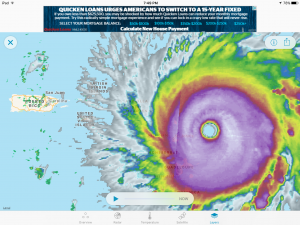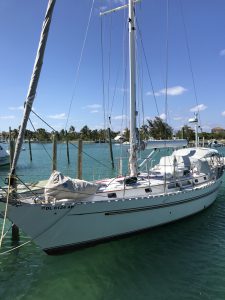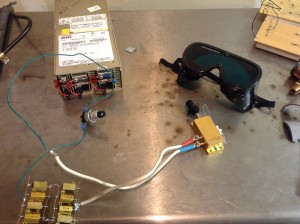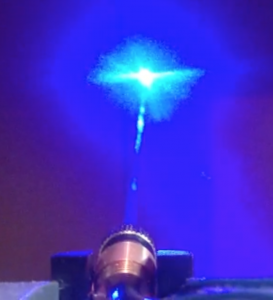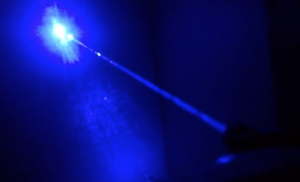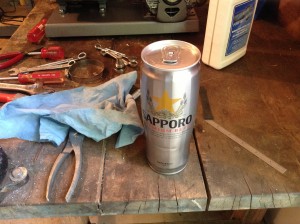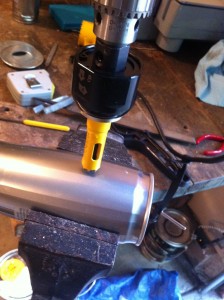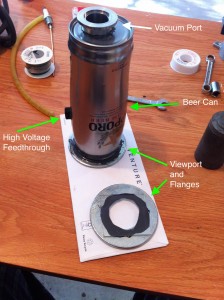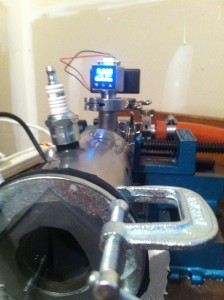News from Puerto Rico
Power of a Hurricane
Finally received some detailed news about Good Karma today. The first was the bad news, the boat next to ours demasted in hurricane Maria and is now leaning on our boat. They had what is called a “deck stepped” mast, meaning the base of the mast is attached to the deck rather than what we have, a “keel stepped” mast attached down to the hull of the boat. A keel stepped mast is much stronger and is the norm for blue water boats.
You may notice in the above photo that not only is our neighbors mast broken off, it is also folded. I am impressed that the hurricane was so powerful it could break what was essentially a pole with a low profile to the wind. Yet it did break, as were many deck stepped masts in the marina. How the mast bent in half the way it did is a mystery.
The good news is that Roberto, the dock master at the marina, said our boat was dry inside and did not mention any other damage. From what we can tell, Good Karma is repairable though how and when is problematic.
Puerto Rico is in dire straights with this disaster. We have heard messages from friends all over the island and they say it is catastrophic. Long lines for food, gasoline, fresh water, the bank. Everything. And this is a week later. Communication is just starting to be restored though power is still out over most of the island. The airport in San Juan is a mess with only a very few flights coming and going. Very few supplies are reaching the island.
This is an American territory and they deserve the response that Huston and Florida have gotten for hurricane relieve, yet they are not. Trump FINALLY suspended the Jones Act, after a week, to allow faster shipping to the island from foreign ports. Shipping businesses have greedily lobbied against this suspension, which meant only American flagged ships could dock and unload in Puerto Rico to protect American shipping companies, the most expensive in the world, from free market shipping.
The Jones Act was suspended for Texas and Florida almost immediately for their hurricane relief, but it took a weeks worth of political pressure to make Trump change his mind about Puerto Rico, while the people there suffer. Unforgivable!
Posted in Uncategorized by Mark with 2 comments.
Impending Irma
It’s Bad
Hurricane Irma is a cat 5 storm with winds topping 175 mph near the center. This storm is HUGE. Notice in the screenshot above that the eye of the storm is almost as wide as Puerto Rico itself, that is big. It is headed over the British and American Virgin Islands and will graze the north shore of Puerto Rico. Hurricane winds will extend a hundred miles from the center.
Good Karma is battened down and tied up as much as possible and we are both in safe places. I am very worried that PR will experience a devastation that will last a long time. The island is in poor financial health in the first place and this will make things exponentially worse. There are over three million people living there who cannot simply drive away.
The next 48 hours will tell, I hope it is not as bad as it looks now.
Posted in Uncategorized by Mark with 2 comments.
Turks and Caicos, Part 2
S/V Good Karma at Turtle Cove Marina, TCI
Ok, after being here on the Turks and Caicos Islands for a few days, we find ourselves quite happy to be back in the “first world.” The Bahamas were OK, but they weren’t quite what we call first world. Not third or second either, more like 1.5 world.
So what the heck does that mean, anyway? Well, first world is kind of like the U.S., where the infrastructure is really quite excellent, most people are middle class and the crime rate is low or at least you know where it is high or low. Third world is where 90% of the population would be considered in abject poverty by U.S. standards. In the third world there is no widespread infrastructure and where it exists, in big cities, it is shaky at best. The crime rate may not be high but there is lots of petty crime caused mainly by the poverty. The Bahamas is certainly not at this level. Oh, and as a side note, I’m not sure what “second world” is so I’m leaving that out. I think it used to be the communist countries?
Anyway, the Bahamas have OK infrastructure, but not great, and you can get most anything but man is it expensive. And for what you pay, they don’t have much to show for it. Common food items are way more expensive. Boat hardware was unbelievably overpriced. Much of this was due to the import and VAT taxes they add on, and there again, not much to show for such high taxes. Locals even complained they have to pay those taxes with nothing to show for them. There was also significant poverty in the Bahamas, though not third-world poverty.
Contrast that with the TCIs (Turks and Caicos Islands). These islands are actually British territory and I believe that is the main difference from the Bahamas, which are their own country. There is conspicuously more money here and as far as we can tell they spend it on infrastructure. The grocery store is well-stocked and not overpriced. No wild dogs chasing us, no trash on the beach. In the resort areas it is much like Hawaii, we concluded, definitely a tourist destination in my book.
So, maybe we’ll retire here!
Posted in Uncategorized by Mark with comments disabled.
ICW Mile 965: Ft. Pierce Inlet
Anchored In Ft. Pierce
Made yet another long overnight jump between ICW inlets and are now finally a few hours away from our first long rest stop. Vero Beach is actually north of us by about 12 miles but we stopped here to rest after the 13 hour journey.
It was very quiet and almost windless over this last leg so the motor was droning on for the entire voyage and we did not sail at all. For some reason on these last two overnight legs I have not been able to sleep much on my rest period but Shelly was able to sleep well which is good. Podcasts do well to help pass the time when there isn’t much to look at. There was a full moon last night and it is quite warm all night, so at least we are back in summer weather. 83 degrees here today!
Posted in Uncategorized by Mark with 1 comment.
Garage Laser Experiments
Blue Laser in Night Sky
Ok, here are some of my recent laser experiments. Kids, don’t try this at home…
First I went out to the web to see what was the most powerful laser I could purchase for a reasonable price. What I found was someone selling the generator from a laser welder. It was pretty cheap so I bought it. I then bought a used power supply that could deliver 30 amps at 5 volts really cheap at an electronics surplus store. The power supply would deliver up to 60 amps so I built a resistor array that would limit the current to 25 amps and added a push button to turn the power on. The resulting setup is shown in the picture below.
The power supply is the box in the upper left. The laser is the gold box center right with the current limiting resistor array bottom left. Now I wanted to turn it on to see what it could do.
Note the safety goggles in the pic above. These are absolutely required for everyone in the room when this laser is turned on. They must filter the correct frequency of light and be rated in strength according to the laser power. Click here to see this laser in operation. The video shows the laser burning a white cardboard box.
This laser has many dangerous characteristics. Besides the obvious risk of fire, this laser can burn skin. But the greatest hazard is to the eye. The light emitted by this laser is ten thousand times brighter than a laser pointer. You should never look directly at a laser of any power because the eye focuses and magnifies the light on your retina up to 100,000 times. That means a moderately powered laser can instantly burn a hole in the retina causing permanent damage. The injury happens faster than the human blink reflex.
There are a couple more insidious hazards for this kind of laser. First, because it is so bright even a reflection off a matte surface (non-reflective) can cause eye damage. And most dangerous of all, the light is infrared, meaning that it is invisible. A camera is sensitive down in the infrared range so you can see it in the video image, but to the eye it is largely invisible.
It’s a good idea to know what you are doing if you decide to turn on a powerful laser like this. I decided to limit my experiments using this particular laser…
So next I explored what was available in a smaller form factor. When you search these things out, you come up with the popular 445nm blue laser diode used in modern video projectors. There are many hackers who have designed tiny driver boards that allow these diodes to be overdriven to more than 3 watts using a small cell phone battery. What that means is that these lasers can be pushed to run more powerful than they are expected to operate in normal conditions. When the laser is overdriven in this manner, it can easily burn at a distance. So of course I decided to build one. I ordered the parts shown below:
The cylindrical object at the top of the photo is what the laser is mounted in, only about an inch long. The round electronic board at the bottom is a hacker designed charge pump board that delivers the high amperage necessary to overdrive the laser. It’s about the size of a quarter. The laser itself is the small object just to the upper right of the round circuit board.
The small round object in the upper right corner is a glass lens. Normally the laser mount has a plastic lens to focus the beam but because this is an overdriven laser, a glass lens is required so that the lens itself won’t melt.
I got this one put together and tested it (wearing the appropriate safety goggles) and it easily burned stuff at close range. I took a pic of the laser firing at a cardboard box above.
Both of these lasers are the result of high tech manufacturing processes, that is, they are built using semiconductor diodes that did not exist only a few years ago. So perhaps the most interesting laser of all is a home built laser that requires nothing but common material and emits ultraviolet light. I was quite astonished at its simplicity, especially given the difficulties encountered in building the first laser in 1960. In that case it took the intense effort of a corporate research laboratory to develop the first working laser. I wonder how much of history would be different if it was known how easy it was to build a laser like I describe in my next post…
Posted in Nuclear Fusion Reactor, Uncategorized by Mark with comments disabled.
Updates
Hey everyone, well I’ve not been in the wild much lately but I have been obsessively working in the lab. The latest two projects have been particle accelerators and lasers. The nuclear reactor is still in progress as well but I need a couple of critical items that are proving difficult to acquire. In the meantime, progress is being made on other evil projects.
One project is the first step in what I feel will be my ultimate cool experiment, a home made cyclotron. It is a relatively sophisticated particle accelerator that moves subatomic particles along a circular path. It can be done and the equipment requirements are similar to what is needed for a fusion reactor. A first step is to build a linear accelerator that can be built with common parts. I was able to do this and I’ll write about it soon.
The other project has to do with lasers. Wow, I have to say that surprised and impressed at what is available to buy on the internet. I will have an entire category dedicated to these experiments. Like the radiation experiments I have been documenting, these lasers are easy to acquire and extremely dangerous. They won’t kill you but they can certainly cause devastating injuries, namely partial or total blindness.
Fun stuff!
Posted in Uncategorized by Mark with comments disabled.
Power controller progress
I spent the evening soldering wires to connectors. I now have the power supply control bus connected up to an Arduino shield. Something tells me OSHA wouldn’t approve..;)
Posted in Uncategorized by Mark with comments disabled.
How to build a vacuum chamber…
Here is a list of easy-to-find parts necessary to build a nuclear fusion reactor and where to find them:
- Beer can (liquor store)
- Oil burner igniter (online spark plug store)
- Threadsaver sized for the spark plug (hardware store)
- Small lexan or polycarbonate sheet (hardware store)
- Two 1.5″ zinc washers (hardware store)
- 6″x6″ thin neoprene sheet (hardware store)
- Four 1″ C-clamps (hardware store)
- Small portion of JB Weld or similar epoxy (hardware store)
- Thread seal tape (hardware store)
- Large gauge wire crimps (Radio Shack)
- Stainless steel wire (Radio Shack)
- KF25 weldable nipple (eBay or scientific vacuum company)
Total cost: $79.40
And actually, it’s much less than that, probably well under $50 due to the fact that the smallest amounts of these items is much more than required for the reactor. The most expensive item was the threadsaver, basically a small sleeve for the spark plug, because they only come in boxes of 8 and you only need one.
How do you build the chamber? Well, first you get the proper beer can. Aluminum won’t do. However, Sapporo beer cans are made out of corrugated steel and are surprisingly strong. You can get them almost anywhere that sells Japanese beer.
The next thing you do is empty the beer. My friend Anna asked, “do you pour the beer out in the sink?” Well yes, that is one method. Another method would be to pour the beer into your mouth and drink it.
When the beer is empty, drill two holes of proper size, the spark hole (below, top) and then the vacuum feedthrough hole (below, bottom).
 Next, cut the top off. This is more difficult than you might imagine, I used some small tin snips and needle-nose pliers to remove the top (pic below). It is much more difficult to do this on a steel can vs aluminum and you should wear proper gloves unless you like multiple, deep cuts on your fingers. This will be the viewport.
Next, cut the top off. This is more difficult than you might imagine, I used some small tin snips and needle-nose pliers to remove the top (pic below). It is much more difficult to do this on a steel can vs aluminum and you should wear proper gloves unless you like multiple, deep cuts on your fingers. This will be the viewport.
 After you’ve finished drilling and cutting, clean out the can with soap and water and let dry. Next, cut the neoprene in the shape of the zinc washer to be used as a gasket, then cut a small square from the lexan sheet (below).
After you’ve finished drilling and cutting, clean out the can with soap and water and let dry. Next, cut the neoprene in the shape of the zinc washer to be used as a gasket, then cut a small square from the lexan sheet (below).
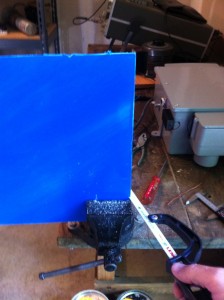 Next step is to epoxy the vacuum and spark plug feedthroughs. Epoxy one of the zinc washers on the viewport end. Epoxy the lexan window to the other zinc washer (see below).
Next step is to epoxy the vacuum and spark plug feedthroughs. Epoxy one of the zinc washers on the viewport end. Epoxy the lexan window to the other zinc washer (see below).
During this process, don’t forget to keep the supervisor happy:
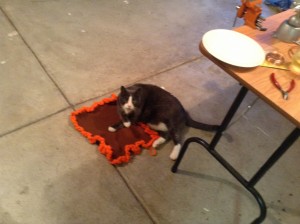 Wait until the epoxy sets, about 24 hours, and then add thread sealant tape to the spark plug and crank it in tight. Clamp together the gasket and window flange to the viewport end.
Wait until the epoxy sets, about 24 hours, and then add thread sealant tape to the spark plug and crank it in tight. Clamp together the gasket and window flange to the viewport end.
Now you’re ready to test the vacuum!
Attach the chamber to a vacuum pump that has an appropriate vacuum gauge (see two pics below):
 Turn on the pump and wait. After several minutes, my chamber read below 70 millitorr (last pic below). That’s good enough for the first step, a “demo” reactor that will generate an air plasma. Cool!
Turn on the pump and wait. After several minutes, my chamber read below 70 millitorr (last pic below). That’s good enough for the first step, a “demo” reactor that will generate an air plasma. Cool!
Next: Hooking up the power !!
Posted in Nuclear Fusion Reactor, Uncategorized by Mark with comments disabled.
Snow is coming!
OK, well after a couple of weeks of temps getting up into the 60s, we’re ready for some snow on the Front Range. Looks like it’s coming. The CAIC forecast for this afternoon:
High clouds are streaming into Colorado from the west and southwest as the next winter storm approaches. This system is a very large low-pressure trough with lots of cold air.
The storm looks big on the radar:
Mountains are supposed to get 2-7 inches new snow. Cool! Maybe we can get some backcountry skiing in this weekend.
Posted in Uncategorized by Mark with comments disabled.
Ouray Ice Climbing

The Ouray Ice Festival is in full swing this week at the Ouray Ice Park.. Below is an article I wrote for Mountain Gazette a few years back:
Colorado Ice Climbing
I was reclining under a dark January sky as enormous snowflakes lighted on my face, feeling like a shower of tingling cold pinpoints. It was an excellent sensory contrast to the soothing hot water in which the rest of my body was submerged. The round wooden tub was fed directly from a natural hot spring behind the Box Canyon Lodge, and was positioned on a hill overlooking the mountain village of Ouray, Colorado.
I quaffed a cold beer, enjoying glimpses of town light glowing on the gray walls of the surrounding valley, walls that rose into a night fog so dense it could conceal this mountain refuge from the world of industry and schedules.
The sound of women laughing in the next tub wafted through the mist. “Yes… He’s a friend of mine and I talked him into letting me use his tool,” one of the women said. Another giggled in reply, “Well, what was it like?”
“It was fantastic!” she exclaimed, “The shaft had an easy grip and the length was perfect. The curve felt kind of strange, but believe me, when I got busy it made all the difference.”
“Did you get wet?” a third woman asked. “Of course! How could I do it without getting wet, silly? You should try it!” They all laughed.
Yeah. Ice climbing. In Ouray, the ice climbing capitol of the West, you rarely hear talk of much else. I took a deep breath of the crisp, pine-tinged atmosphere well below freezing. As I kneaded stiff muscles in the calescent pool, I reflected on my need to ritualistically suffer on frigid walls of ice. The motivations are complex, but let’s immediately put to rest the idea that ice climbing is merely another sport for adrenalized thrill-seekers attempting to live on the edge.
Of all my climbing experiences, from the thin air of high-altitude mountaineering to roped technical rock, ice climbing is uniquely gratifying. Unlike a rock route literally fixed in stone, the line of an ice route is essentially as you choose it. It is like the difference between a resort skier descending a groomed run versus a telemark skier savoring first powder tracks in a backcountry bowl.
On ice you must be completely self-reliant. Because your life and limb depend on your actions, you are forced into Zen-like clarity of mind directed at your very place and moment. Like a Buddhist master, you are fully immersed in here and now.
At the finish of a difficult route, you enjoy the victory of having crafted your own line of ascent. It is not uncommon to feel like a prophet reeling from a metaphysical vision. Your core spirit is energized, enlightened, and you know you are alive.
Much of the time that vision extracts a toll. Among the most-common and excruciating experiences ice climbers suffer is the rewarming of hands. The thickest practical gloves used by ice climbers cannot perfectly insulate. And gripping an ice tool above your head further drives the blood from your fingers.
Re-establishing full blood flow can be tortuous. Your fingers feel as if they are being crushed by pliers as a blowtorch sears your flesh. No kidding. It is perhaps one of the most painful experiences possible that does no actual harm. There is no relief as your world spins in eye-watering agony for several minutes.
By the time the water had re-warmed my body, the snow had accumulated two inches outside the tub. I scurried to my room with my hair and beard encased in ice. After drying off, I dressed and hiked a few blocks to Buen Tiempo, a bar famous for warming fleece-clad climber’s fresh off the ice. I sipped margs with climbing buddies old and new, laughed at our ice follies, admired tales of difficult ascents and anticipated ambitious plans for the next day. Climbers from Colorado and beyond crowded in and loud conversation reverberated off the walls. We were a tribe celebrating our bonding rite.
The next morning I was shivering in knee-deep snow at the base of a blue-gray ice wall, intentionally stripped down to minimal clothing. I would soon work myself into a sweat. I struggled to tie into a frozen-stiff rope. I swung an ice tool, sinking the pick into plastic ice. I repeated the action with my other tool. I then kicked my right foot into the ice knee-high, sticking my crampon frontpoint perpendicular to the wall. I stepped up. I alternated this action, tool and crampon, until I was twenty feet above the ground.
I twisted a screw into crackling ice. Frigid water that was running down the wall also ran into my sleeve, sending a cold rivulet down my arm and torso. I clipped my rope and continued up, shoulders and calves burning. I hammered the ice and unintentionally cracked off a chunk the size of a dinner plate above me. It nailed me in the face, drawing blood and swelling my lower lip. I looked like I was on the losing end of a bar fight. I continued up.
The ice constantly changes. I love it.
—Mark Scott-Nash

Posted in Uncategorized by Mark with comments disabled.

